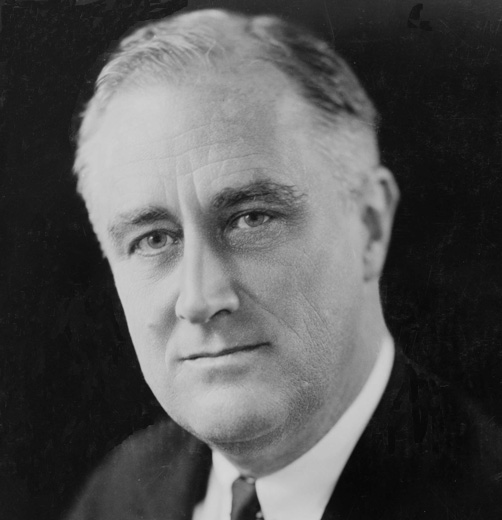President Franklin Roosevelt: The Great Depression, The New Deal, and The War

FDR: The Start of a New Presidential Era
As the 32nd President of the United States, Franklin Delano Roosevelt (1882-1945) aka FDR had not only the longest presidential reign, spanning four terms from 1933-1945, but also arguably the most challenging. Throughout the Presidential era of Franklin Roosevelt, the U.S. faced two of its greatest crisis in the Great Depression and World War II. Roosevelt’s optimism and activism made him both one of the most admired presidents of all-time and a president that was subject to many criticisms.
In 1933, the U.S. was in the depths of the Great Depression. Unemployment rates had risen to around 25% and homelessness was in the millions. With paranoia of losing their money, people withdrew their money from banks, causing a banking crisis. The same paranoia, along with the aforementioned unemployment caused reluctance in people to spend money, thus dragging down the economy into further crisis. Farming communities were struggling as mass production caused prices to fall so low that farmers could not pay their debts causing even further crisis.
FDR: The Great Depression and The New Deal
Upon taking office, Roosevelt took active and immediate action in what is commonly known as Roosevelt’s “first 100 days” and the New Deal. The New Deal was a series of economic policies implemented for the purposes of relief, recovery, and reform from the Great Depression. Roosevelt started by declaring a “bank holiday”, closing down banks for four days while passing emergency banking legislation through congress. Congress overwhelmingly passed Roosevelt’s Emergency Banking Act which assisted banks and later led to the institution of the FDIC, and thus restored some of the nations trust in the banking system. A year later Roosevelt pushed an act which set up the long-lasting Securities and Exchange Commission which policed the stock-market and provided people the comfort investing in the stock-market once again.
Another immediate cause of action taken by Roosevelt’s administration was establishing the Agricultural Adjustment Act. Under the theory of supply and demand economics, the AAA was a government act that rewarded farmers for their reduction in crops, causing higher prices and greater profits for farmers. Roosevelt believed that a rise in prices would result in a rise of wages and thus aid in the restoration of the economy. That theory led to the establishment of the National Recovery Administration. The NRA structured minimum wages and set forth a 35-40 hour work-week.
The Roosevelt administration further worked to create jobs for those who were unemployed through the Civilian Conservation Corps and the Public Works Acts. The Public Works Act provided jobs for large construction projects on streets, highways, schools, hospitals and airports. The CCC provided jobs to young men to build parks and provide conservation efforts by duties such as planting trees and working in forests. Much like the CCC, one of the more successful New Deal measures was the creation of the Tennessee Valley Authority. The TVA provided navigation, flood control, and energy generation throughout the Tennessee valley.
Although the U.S. was not yet restored on many levels to its prosperity prior to the depression, many of the reform, relief , and recovery acts set forth by the Roosevelt administration provided a sense of optimism and brought a moderate degree of recovery to the country. Roosevelt was admired by many, especially minority groups, including women and blacks who obtained jobs. Roosevelt also made the landmark decision to eliminate prohibition of alcohol by the institution of the 21st Amendment in 1933.
Due to the vast changes Roosevelt made, his spending reached record levels. Roosevelt tried to balance the budget by the establishment of the Economy Act of 1933. This act cut the salaries of government employees, including the reduction of benefits for foreign-war veterans. The Economy Act made Roosevelt subject to criticism by critics and through the protests and uproar set forth by veterans.
Although the U.S. had made vast strides in the depression by 1935, there was still economic crisis and a large unemployment rate. As such, Roosevelt retooled the New Deal and passed a series of new acts-- many of which taxing the rich and striking down on big businesses. One example being the Wagner Act, later named the National Labor Relations which gave workers in big business the right to unionize and bargain with big businesses.
Roosevelt also continued to create more jobs for the unemployed by way of the Works Progress Act which, much like the Public Works Act, created jobs for all kinds of people by creating theatre and art projects as well as construction projects. Additionally, the Roosevelt administration is responsible for the creation of the Social Security Act, which to this day provides pensions and assistance to the retired, in addition to unemployment insurance to those who are laid off or become disabled.
In addition to being considered a hero by many, Roosevelt also had his critics. Roosevelt’s profound activism led critics to believe that Roosevelt was ridding the U.S. of free-enterprise and turning it into a Communist Dictatorship. There were also beliefs that his New Deal was pushing the country into a worse depression. By his second term, many of the New Deal acts were discontinued after being deemed unconstitutional. Upset at the Supreme Court for making such declarations, Roosevelt may have bruised his reputation by sending a new bill to congress that would appoint six more Supreme Court justices. Some believe that was done to change the balance of the Supreme Court into his favor in order to prevent future acts from being deemed unconstitutional. Unsurprisingly, Congress rejected Roosevelt’s proposal.
By 1937, the nation was nearly restored to the level that it was prior to the Great Depression. Roosevelt then felt it was in the best interest of the country to cut down his profound spending on the remaining New Deal programs in order to balance the budget. As a result, the nation went into recession thus setting the nation back to where it was in the depths of the Depression prior to Roosevelt’s inauguration. Roosevelt realized his mistakes and returned to his abundant spending ways. In his second term, the Roosevelt administration did not create many more acts; however, the creation of the Fair Labor Standards Act in 1938 officially set a minimum wage and a 40 hour work-week.
How would you rate FDR's Presidency?
FDR: Involvement in World War II
By 1938, the Great Depression was not entirely over, but Roosevelt began to focus his attention to future peaceful relations throughout the world and the war that the world appeared to be inevitably headed into. As expected, in 1939, Germany invaded Poland and World War II had begun. Roosevelt envisioned a post-war world that lived by the “Four Freedoms” of religion, speech, freedom from want, and freedom from fear. Roosevelt had previously broken away from isolationism through his “Good Neighbor” policy by opening up trade with the southern bordering countries; and he brought this ideology to another level through his alliance with Britain, France, the Soviet Union, and China in creating the Atlantic Charter with Winston Churchill, and the United Nations in effort to maintain peace in the post-war world. Although Roosevelt initially wanted to keep the U.S. physically out of the war, he decided to greatly stray from his prior beliefs and increase military spending, in addition to building up the U.S. military in creation of what he called the “arsenal of democracy”. After a German blitzkrieg of France, Roosevelt recognized to Britain’s susceptibility to being hit next, and as a result, Roosevelt set forth the Lend- Lease Act in 1941 which funded further aid to Britain.
In
1941, the U.S.
was outraged and forced to enter the war after the Japanese attack on Pearl
Harbor. At the same time, Germany
and Italy
declared war on the United States. It became Roosevelt’s
quest to first defeat Nazi Germany and then ultimately defeat the Japanese
Roosevelt, as always, took on a leadership role and appointed effective war
generals and came up with a masterful game plan with the allies which ultimately led to victory.
FDR: Death and Influence
Shortly into his fourth term in office and right before the official ending to the war, Franklin Roosevelt died. The Great Depression was finally over, in large-part to Roosevelt’s efforts. By way of his leadership in two of the greatest crisis in American history, FDR is considered by many to be one of the greatest President’s of the United States. Although critics state that Roosevelt would not have been held in such high regard if not for his leadership in World War II, Roosevelt undeniably changed the role of government in the U.S. by way of active roles in pushing legislation. Roosevelt’s success empowered the Democratic Party for decades ahead. Because of Roosevelt’s timely leadership, the U.S. has to this day held on to the characteristics of being the world’s greatest economic, political, and military power.









